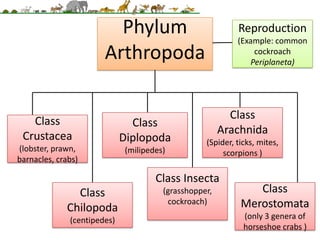Arthropoda
- 1. Phylum Arthropoda Class Crustacea (lobster, prawn, barnacles, crabs) Class Chilopoda (centipedes) Class Diplopoda (milipedes) Class Insecta (grasshopper, cockroach) Class Arachnida (Spider, ticks, mites, scorpions ) Class Merostomata (only 3 genera of horseshoe crabs ) Reproduction (Example: common cockroach Periplaneta)
- 2. Class Merostomata The body are protected by a hard shell, divided into a cephalothorax and abdomen Bear six pair of appendages, the chelicerae, pedipalps and four pairs of walking legs. They live in deep water and feed on molluscs and annelids. Considered living fossils –structure has remained basically unchanged for the last 300 million years Pedipalp Limulus sp. (horseshoe crabs)
- 3. Class Chilopoda Clearly defined head with a pair of antennae and a pair of mouthparts. The elongated body consists of numerous segments. Each segment bears a pair of similar appendages. Eyes are simple, compound or absent Carnivorous and feed mainly on insects, which they capture and kill using poison fangs on first segment after the head Maxilliped (poison claw) Lithobius sp. (centipede)
- 4. Class Diplopoda The body segments bear two pairs of legs each. Each segment also has glands which secret a foul- smelling liquid which protects them from attack. Most are herbivores that feed on live or decaying vegetation. They play an important role in the detritus food chain. Lulus, common millipede
- 5. Class Arachnida •Body are divided into cephalothorax (prosoma) and abdomen (opisthosoma) •4 pairs of walking legs n simple eyes. •No antennae, the function of antennae is performed by numerous sensory hairs which cover the body and appendages. •*Have a pair of chelicerae (fangs or pincers) which are often connected to a poison gland. •*Have a pair of pedipalps ( second pair of appendages) which may used to hold food, act as sensory organ of taste or as pincers to capture prey. •Mostly are carnivores that feed on other arthropods especially insects, which they will digest externally before ingesting it. Lycosa ( spider)
- 6. Class Insecta Have clearly defined head, thorax, abdomen, a pair of antennae , 3 pairs of mouthparts. 3 pairs of legs each thoracic segment with a pair of legs), a pair of compound eyes and simple eyes. Adults have one or two pairs of wings. Locusta, an insect The life cycle of insects is characterised by several moults. The stage between two consecutive moults is called an instar Some insects show incomplete metamorphosis, that is, the eggs hatch into nymphs which resemble the adults in most ways, except that they lack wings and are sexually immature. After the last moult, the adult (imago) emerges. There are four distinct stages in complete metamorphosis : egg larva pupa imago The larvae are morphologically, physiologically and behaviourally different from adult.
- 7. Class CRUSTACEA They have a cephalothrorax whereby the head is not clearly distinct from the thorax. They have 2 pairs of antennae , at least one three pairs of mouthparts (jaws), a pair of compound eyes raised on stalks. They have appendages on their abdomen as well as on their thorax. The appendages in different parts of the body are specialised to perform different functions: feeding, locomotion, reproduction and sensory structure. They lack a waterproof exoskeleton. They use gills which are outgrowths of the body wall or limbs for gaseous exchange. Have separate sexes. The male use s specialised appendages to transfer sperm to the female. Fertile eggs may be carried on the body. When the eggs hatch, they develop into nauplius larvae which is the characteristic larval form of all crustaceans. The larvae go through a number of moults before reaching maturity. Penaeus sp. (prawn)
- 8. Male and female cockroach (Clasper) The male cockroach has a pair of claspers that grasp the female during copulation. The number of visible segments is higher in the male than the female. Also the females posterior abdomen is broader and more rounded than the male
- 9. Reproduction system of male cockroach A pair of testes to produce sperm Vas deferens Seminal vesicles Ejaculatory duct Penis **Accessory gland secret fluid that is mixed with the sperm before ejaculation. Vas deferens
- 10. Reproduction system of female cockroach A pair of ovaries, each made up of eight ovarioles which produce ova. Oviducts Vagina ** Accessory glands secrete chemical to make the ootheca, an egg sac. ** Spermathecal connected to vagina, which store the sperm ejaculated from the male cockroach during mating.
- 11. 1. During mating, The tips of the abdomens are held close together, then a package of sperm wrapped in a protein capsule is inserted into the vagina of the female by means of extensible penis 2. When the insect separate, the spermatophore ruptures and the sperm swim to the spermatheca. 3. After mating, ova are passed down the vagina and fertilised by the sperm in the spermatheca. 4. The fertilised eggs are carried in ootheca . It is carried to the insect for a few days before it is shed, usually in dark place. 5. When the ootheca breaks after about six weeks, the young nymphs emerge. **Cockroach shows Hemimetabolous development (insect development in which there is incomplete or partial metamorphosis, typically with successive immature stages increasingly resembling the adult)











